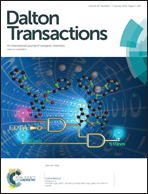Molecular tectonics: anion control of dimensionality and connectivity in meta-pyridyl appended tetramercaptotetrathiacalix[4]arene based silver coordination networks†
Abstract
The combination of the same organic tecton 1, a meta-pyridyl appended tetramercaptotetrathiacalix[4]arene in 1,3-alternate conformation offering four pyridyl units and eight thioether groups, with three silver salts AgX (X = BF4−, NO3− and SbF6−) leads, under identical conditions (concentration, temperature and solvent system), to the formation of different silver coordination networks. Both the connectivity and the dimensionality of the three silver coordination networks depend on the nature of the anion used as a counter ion. Whereas the weakly coordinating BF4− anion does not participate in the formation of the non-tubular 1D coordination network, the coordinating NO3− anion is bound to the metal cation and this leads to the formation of a tubular 1D silver coordination network. In both cases, the eight S atoms of the tecton 1 do not take part in the binding of the cation. In marked contrast, when the SbF6− anion is used as a counter ion, the organic tecton 1 behaves as a tetrakismonodentate through its four meta-pyridyl moieties and as a bischelating unit of the SCCS type leading thus to the formation of a porous 3D diamondoid-type network.
![Graphical abstract: Molecular tectonics: anion control of dimensionality and connectivity in meta-pyridyl appended tetramercaptotetrathiacalix[4]arene based silver coordination networks](/en/Image/Get?imageInfo.ImageType=GA&imageInfo.ImageIdentifier.ManuscriptID=C3DT52654B&imageInfo.ImageIdentifier.Year=2014)

 Please wait while we load your content...
Please wait while we load your content...